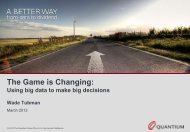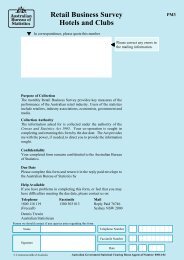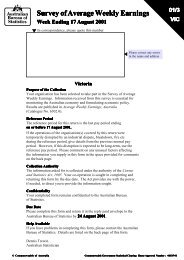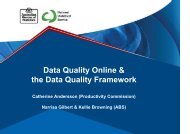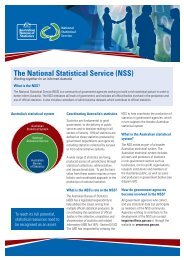SAE Manual Sections 1 to 4_1 (May 06).pdf - National Statistical ...
SAE Manual Sections 1 to 4_1 (May 06).pdf - National Statistical ...
SAE Manual Sections 1 to 4_1 (May 06).pdf - National Statistical ...
You also want an ePaper? Increase the reach of your titles
YUMPU automatically turns print PDFs into web optimized ePapers that Google loves.
A Guide <strong>to</strong> Small Area Estimation - Version 1.1 05/05/20<strong>06</strong><br />
Figure 4.2: Key Questions for Small Area Modelling<br />
If NO<br />
Q1. Do you have good quality auxiliary Data?<br />
If Yes<br />
Use Linear or Generalised<br />
linear models, depending<br />
on your data.<br />
Q2. Is the variable of interest of continuous, binary or<br />
count data?<br />
If<br />
Continuous<br />
data: Linear<br />
model<br />
If Binary<br />
data:<br />
Logistic<br />
Model<br />
If Count<br />
Data:<br />
Poisson<br />
model<br />
Simple<br />
Direct or<br />
Broad Area<br />
Ratio<br />
Estima<strong>to</strong>rs<br />
are the<br />
likely<br />
candidates.<br />
Q3. Shall I use an area-level or unit-level model or both?<br />
Q4. At what level is my auxiliary data available and of<br />
good quality?<br />
Good Area Level<br />
or unit level<br />
continuous data<br />
Good<br />
Unit Level binary<br />
data<br />
Good Area Level<br />
count data<br />
Q5. Are there likely <strong>to</strong> be major differences between<br />
small areas that are not taken in<strong>to</strong> account by the<br />
auxiliary data?<br />
If Yes<br />
Use random effects model<br />
Consult methodology<br />
staff for technical advice<br />
The next key question (as indicated by questions 5 of Figure 4.2) is when and why do we<br />
use the random effects models as compared <strong>to</strong> the synthetic models. To start with, the<br />
preceding discussion on the choice of models (linear versus generalised linear) also<br />
applies <strong>to</strong> the random effects models as well. However, the random effects models are<br />
different in that they include an additional error component <strong>to</strong> account for differences<br />
between units that aren’t explained by the auxiliary variables. In other words, synthetic<br />
models assume that the variable of interest can be determined from the same functional<br />
relationship with the auxiliary variables, and that this relationship applies across all small<br />
areas.<br />
This assumption, however, could be restrictive for a number of reasons. For example, in<br />
the disability data some small areas are located in remote areas with limited support<br />
facilities and services while others are in big cities with better infrastructure and services<br />
where people with disability could move there <strong>to</strong> take advantage of the improved<br />
services. Some areas are may have larger population of indigenous people relative <strong>to</strong><br />
others which again may affect disability rates in different areas. Yet, others are located in<br />
coastal areas that attract people of retirement age and the elderly. These fac<strong>to</strong>rs are not<br />
fully accounted for in the auxiliary data. Thus, unless these and other fac<strong>to</strong>rs are taken<br />
in<strong>to</strong> account in the model, they could limit the predictive abilities of synthetic models<br />
Australian Bureau of Statistics 31




